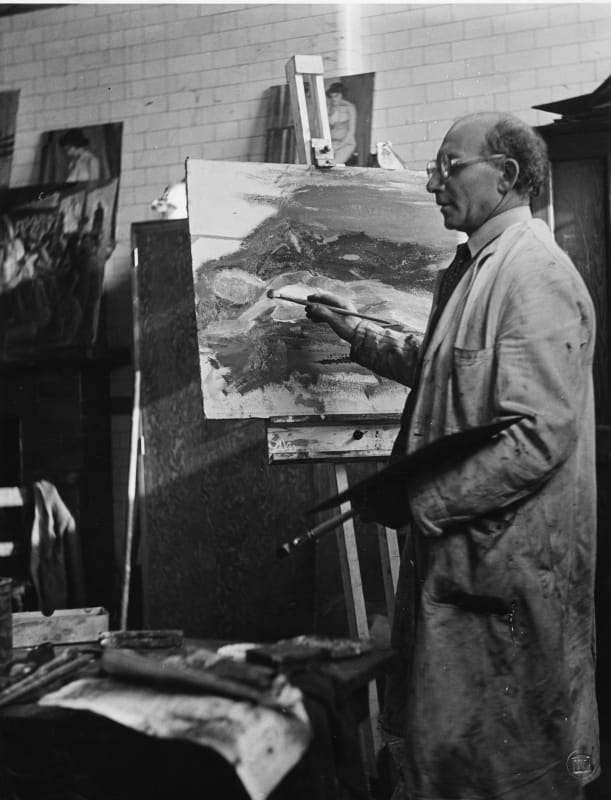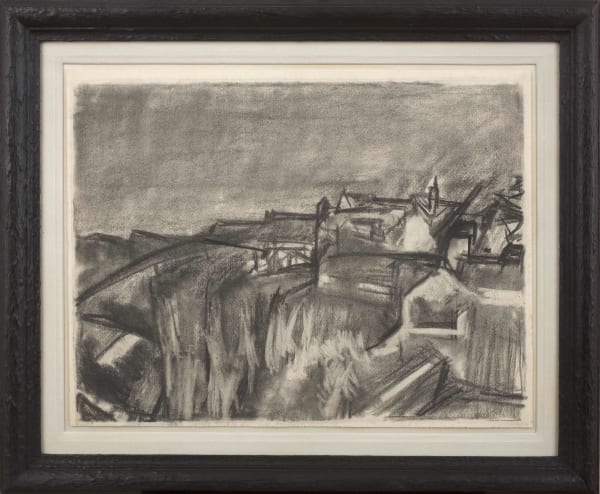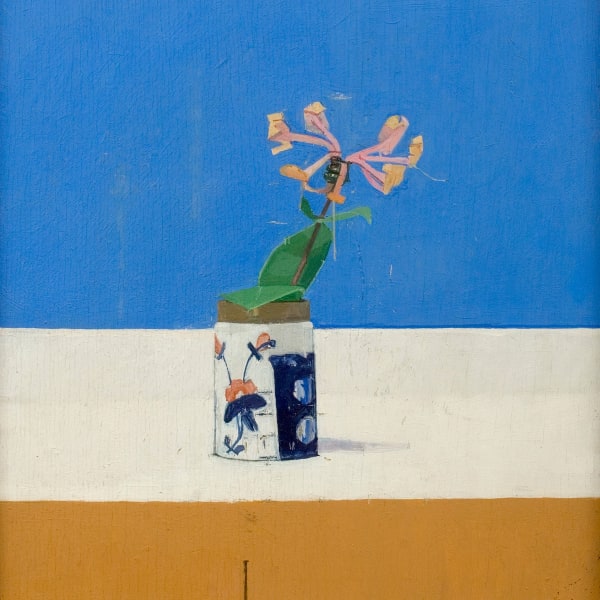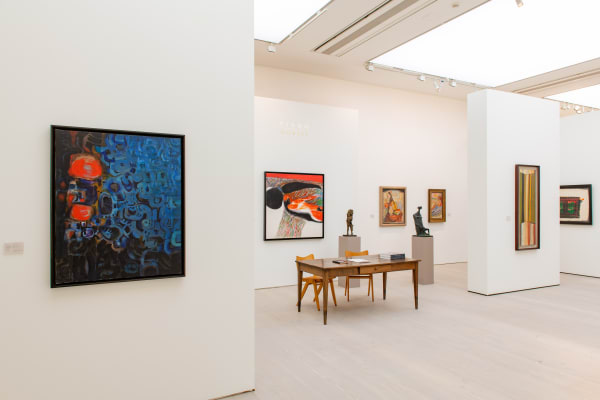David Bomberg
The gallery regularly handles, acquires and advises on works by David Bomberg. For more information or the availability of work, please contact the gallery.
David Bomberg (1890 - 1957)
David Bomberg was born into an impoverished Jewish-Polish immigrant family in Birmingham in 1890. He started his career in 1905 as an apprentice lithographer, and later followed courses at Westminster School of Art (1908-1910). From 1911 to 1913 he was the pupil of Walter Richard Sickert at the Slade School of Fine Art, at the same time as Mark Gertler, Paul Nash, Christopher Nevinson and Stanley Spencer, funding himself through art school by working as a life model. Already hugely influenced by experimental art in Europe, particularly Cubism and Futurism, Bomberg travelled to Paris in 1913 and in this year he was expelled from the Slade. Bomberg was loosely affiliated with many avant-garde groups in London including Roger Fry's Omega Workshops and the Camden Town Group but his angular, bombastic, violent paintings in the two years leading up the war reveal his proximity to Wyndham Lewis's Vorticist Group with whom Bomberg exhibited in 1915, although Bomberg turned down an invitation to officially join the group. Several masterpieces from these early years are held by the Tate Gallery, London including In The Hold (1913-14) and The Mud Bath (1914).
Bomberg served in the trenches during World War I, and during the war both his brother and his close friend and fellow Slade student Isaac Rosenberg died. After 1918, and especially from 1920 onwards, he practised a rigorous Cubism, based on powerful angular forms and near to abstraction, although centred around figurative reference points. In 1929, after a trip to Spain, he abandoned his previous style, turning instead to a more informal whilst still dynamic Expressionism in which line is subordinate to stark, thickly built-up colour. He subsequently applied this style to the landscapes of England and especially of Spain and Palestine, as well as to self-portraits or portraits of his wife and close members of his family. Between 1946 and 1953 he was a lecturer at Borough Polytechnic, teaching such young painters as Frank Auerbach and Leon Kossoff, and he also exhibited with the Borough Group and Borough Bottega. He died in 1957 in London.
-

Bomberg / Marr
Spirits in the Mass 2017Softback, 74 pagesRead more
Publisher: Piano Nobile Publications
ISBN: 978-1-901192-50-6
Dimensions: 28 x 24 cm -

The Nobile Index Series
Box Set Various, 2017Box SetRead more
Publisher: Piano Nobile Publications
ISBN: 978-1-901192-49-0
Dimensions: 28.4 x 16.4 x 4.7cm -

20th Century Modern British Art
Developments in Modern British Art 2013Booklet, 8 pagesRead more
Publisher: Piano Nobile Publications
Dimensions: 15 x 20 cm -

Auctioning David Bomberg
A Sales History 1990-2010 Dr Louise Hughes, 2012Sewn paperback , 36 pagesRead more
Publisher: Piano Nobile Publications
Dimensions: 16 x 28 x 1 cm
-

Treasure House Fair
Royal Hospital Chelsea 27 Jun - 2 Jul 2024 Art FairPiano Nobile returned to The Treasure House Fair in June of 2024. We highlighted works from across the twentieth century, with early paintings by Augustus John and Walter Sickert, Duncan...Read more -

Treasure House Fair
Royal Hospital Chelsea 22 - 26 Jun 2023 Art FairThe Treasure House Fair is a celebration of outstanding and rare art and antiques. Held at The Royal Hospital Chelsea the fair continues the tradition of its predecessors, Masterpiece and...Read more -

Masterpiece
Online Viewing Room 23 - 27 Jun 2021 OnlinePiano Nobile participated in Masterpiece Online 2021. We highlighted a selection of outstanding work by twentieth-century British artists, including paintings, sculpture and drawings by Leon Kossoff, Lynn Chadwick, Lucian Freud...Read more -

Masterpiece
Online Viewing Room 22 - 28 Jun 2020Highlights from our online display included work by Ben and Winifred Nicholson, William Turnbull, Leon Kossoff, Frank Auerbach, William Crozier, David Bomberg, Lucian Freud and Barbara Hepworth . Also on...Read more -

British Art Fair
Saatchi Gallery 20 - 23 Sep 2018 Art FairPiano Nobile presented a selection of Post-War and Modern British art, including works by Craigie Aitchison, Kenneth Armitage, David Bomberg, Peter Coker, William Crozier, Leslie Marr, Leon Kossoff, Paul Nash,...Read more -

Modern British Masters (III)
Selected Highlights 29 May - 20 Jun 2018 Piano NobileContinuing a series of exhibitions on the theme, Piano Nobile presented a display of Modern British Masters. Stretching from the birth of modern art at the beginning of the twentieth...Read more -

Bomberg / Marr
Spirits in the Mass 17 Nov 2017 - 19 Jan 2018 Piano NobileBomberg / Marr: Spirits in the Mass examined the personal and creative bonds uniting two pioneers of modern British painting. This exhibition formed the second instalment in a series exploring...Read more -

Masterpiece
Royal Hospital Chelsea 27 Jun - 5 Jul 2017 Art FairThe gallery presented a selection of Modern and Contemporary British and International artists including works by William Scott, Tracey Emin, Lucian Freud, Augustus John, Duncan Grant and Vanessa Bell, Eduardo...Read more -

Masterpiece
Royal Hospital Chelsea 28 Jun - 4 Jul 2012 Art FairThe Gallery presented a selection of work by European Modernists including Walter Sickert, Christopher Wood, Hans Hartung, Anthony Caro and William Turnbull.Read more
-

InSight No. 146
David Bomberg | Bomb Store April 12, 2024Having been an official war artist in the First World War, David Bomberg felt himself well equipped to serve when another general war broke out...Read more -

InSight No. 78
David Bomberg | Ronda El Barrio, San Francisco, 1954 July 21, 2021As summer heat starts to build, withering the grass and scorching the earth, David Bomberg's Spanish vistas provide an equivalent in art - charcoal visions...Read more -

A Crisis of Brilliance 1908-1922
Dulwich Picture Gallery October 8, 2013Between 1908 and 1922, C.R.W Nevinson, Stanley Spencer, Mark Gertler, Dora Carrington, David Bomberg and Paul Nash, studied together at the Slade School of Art...Read more





















